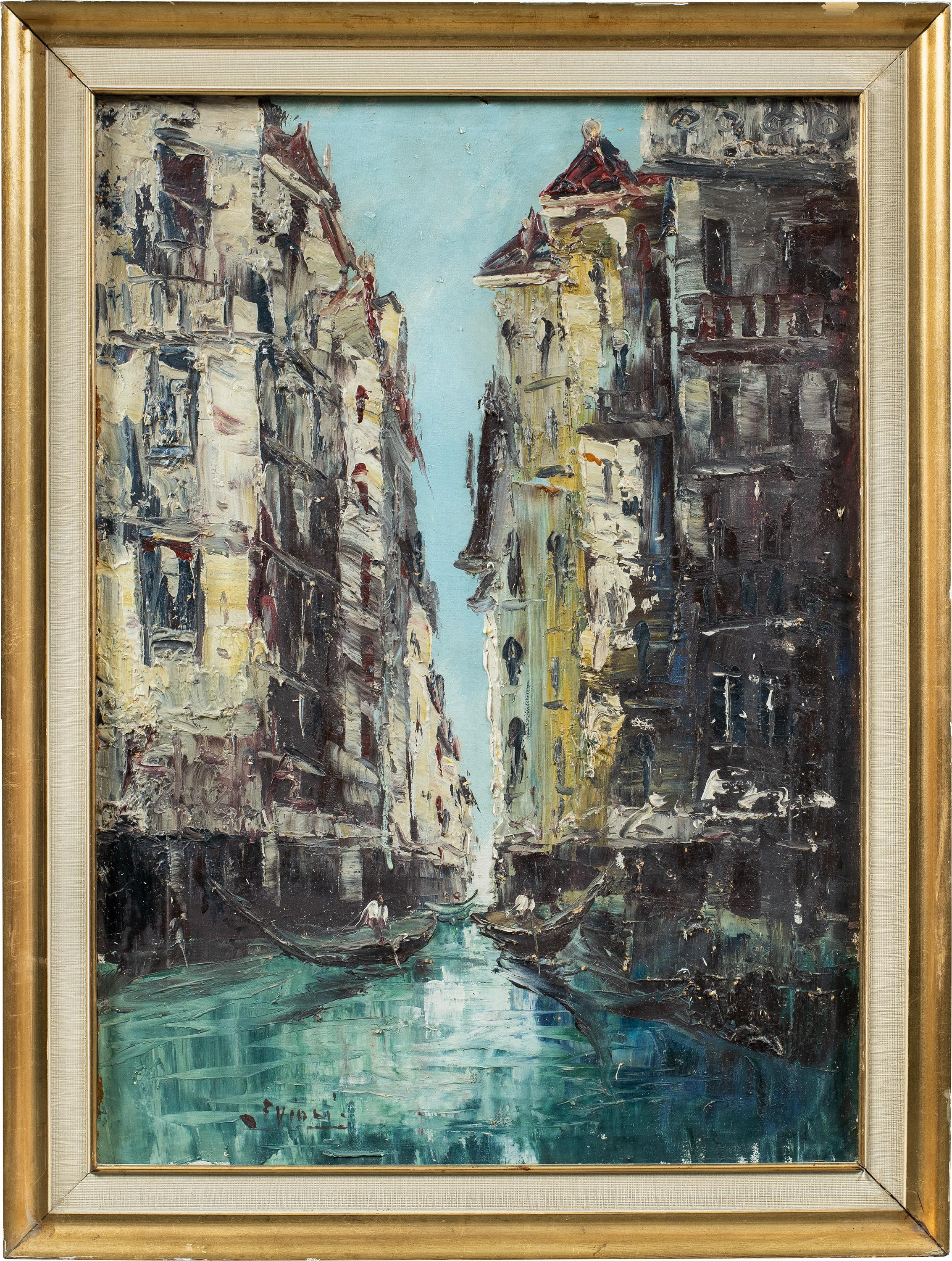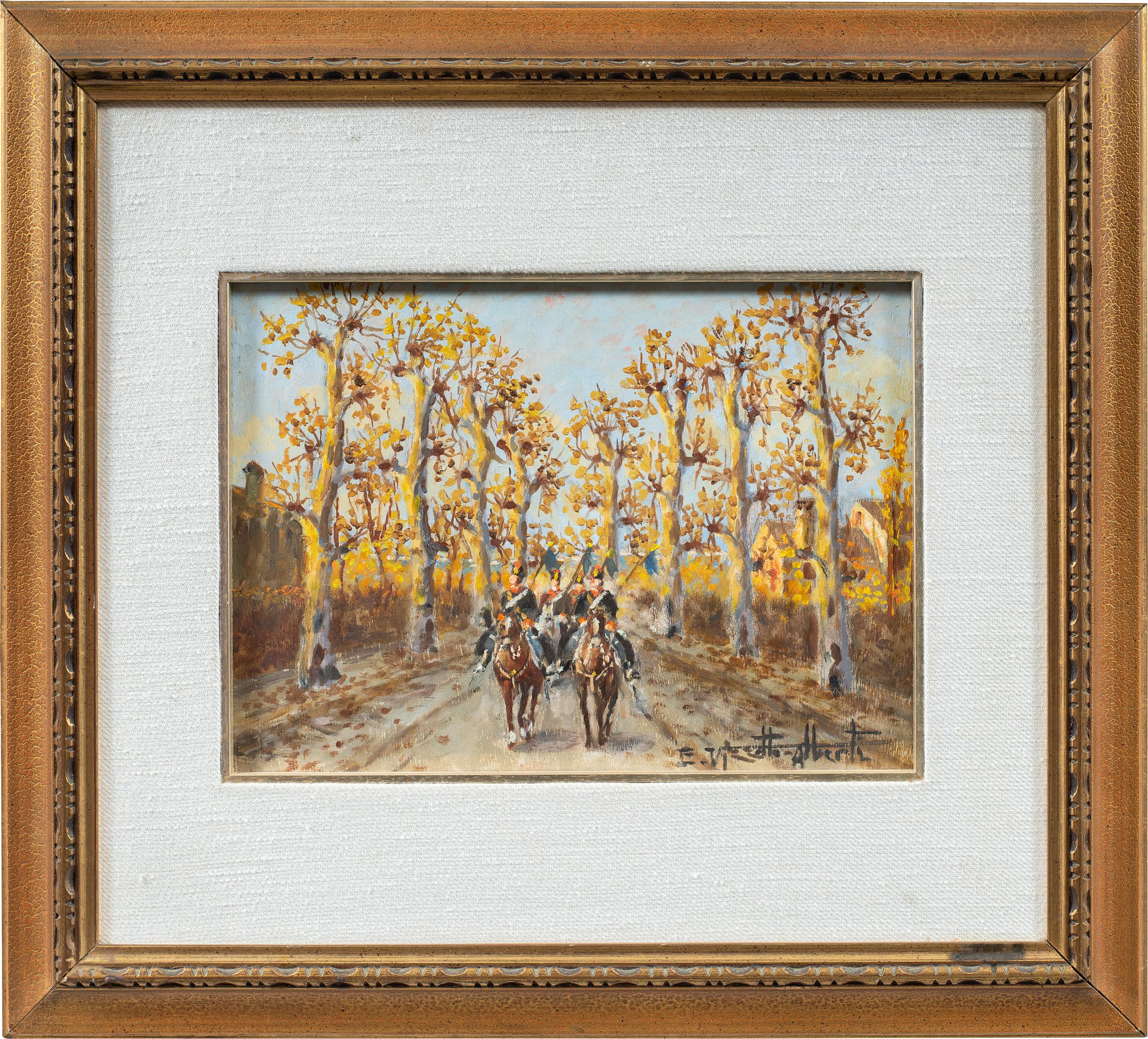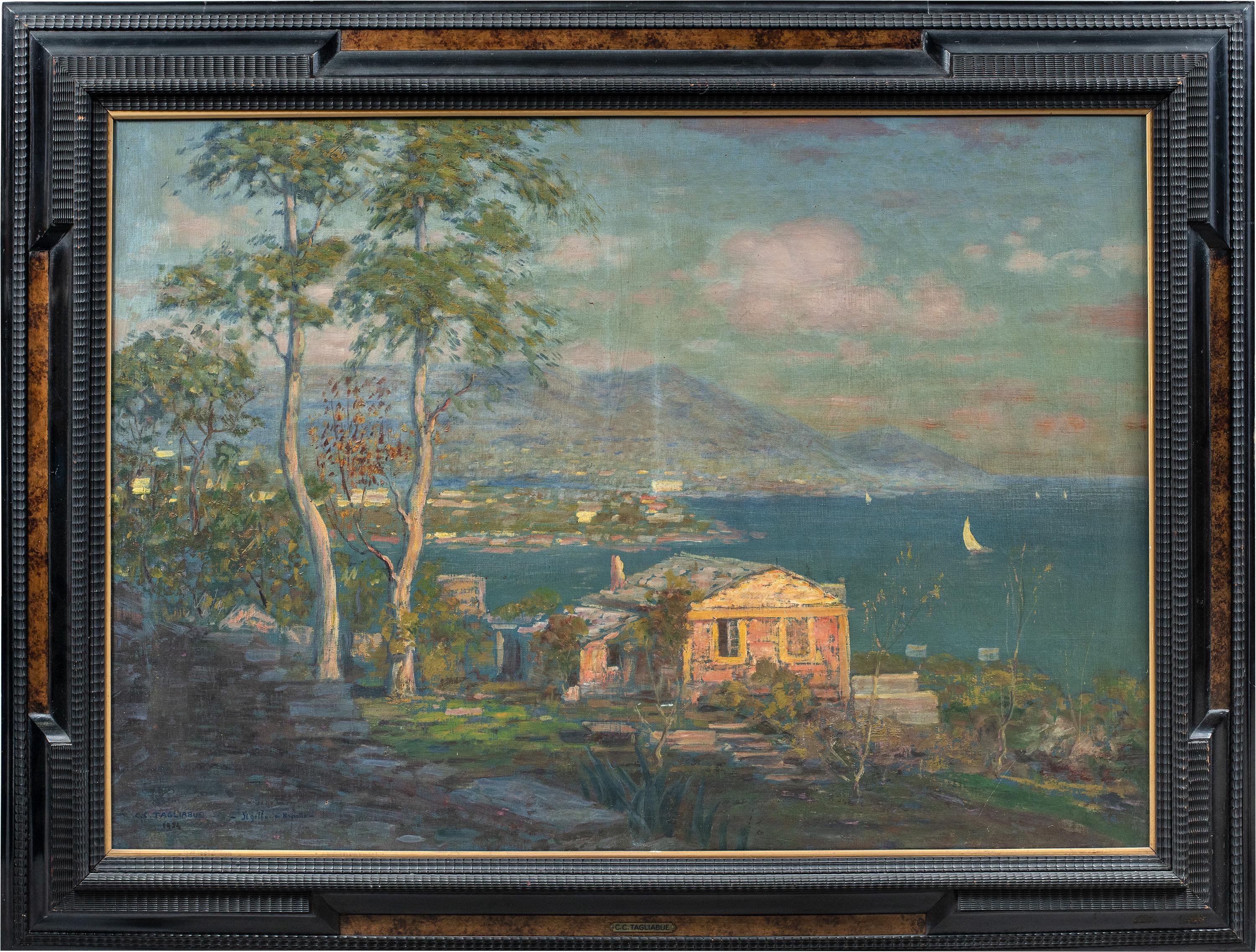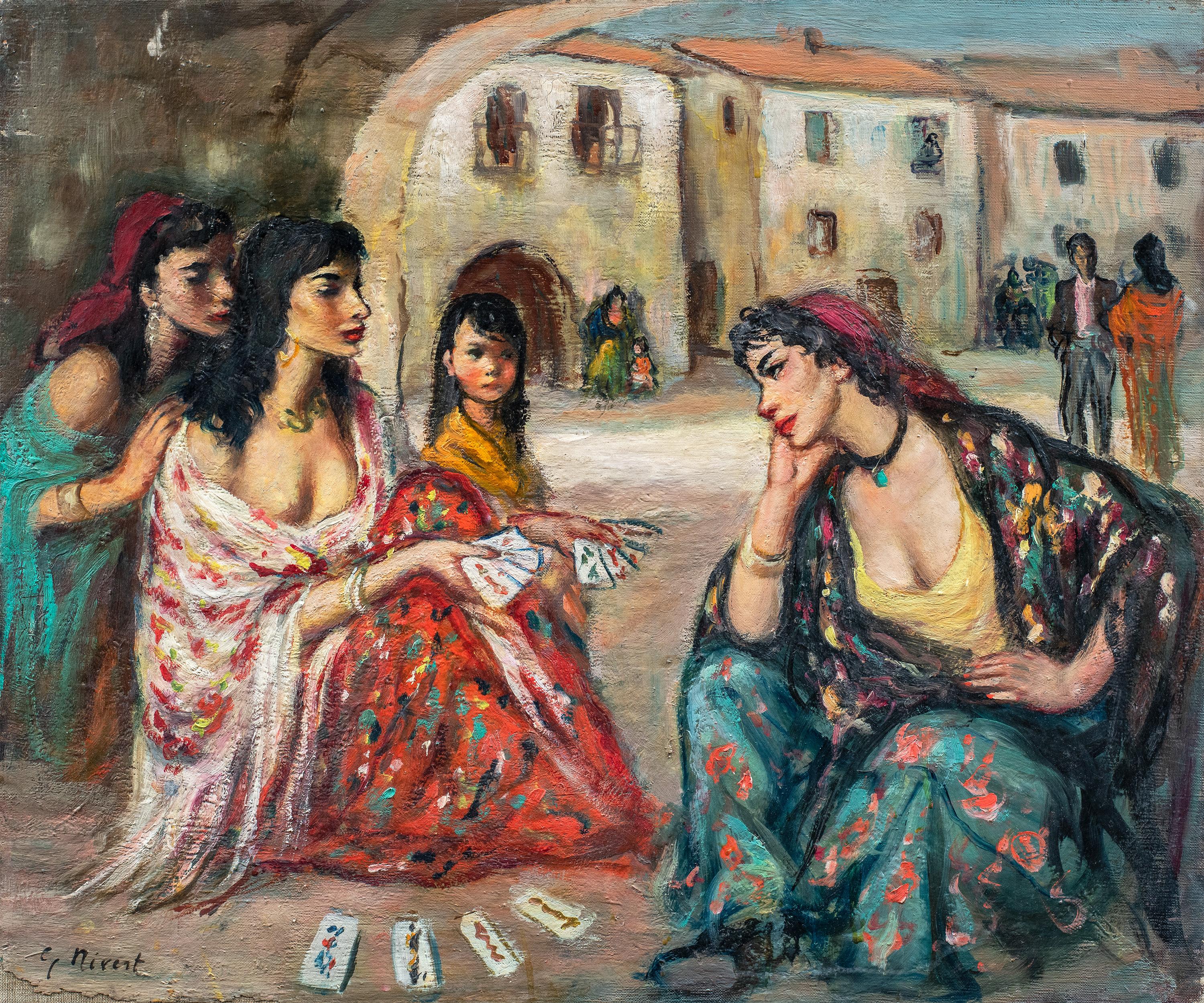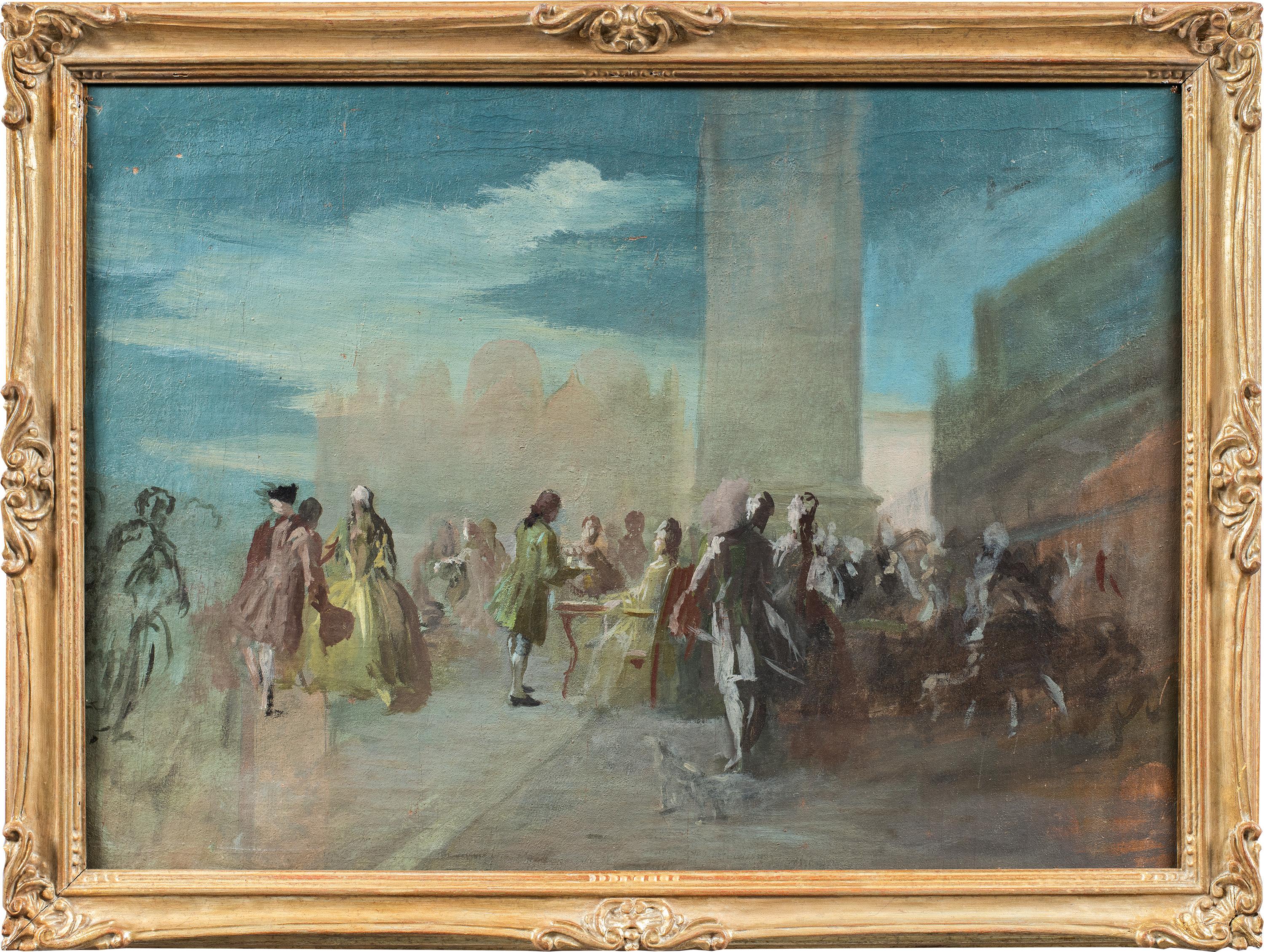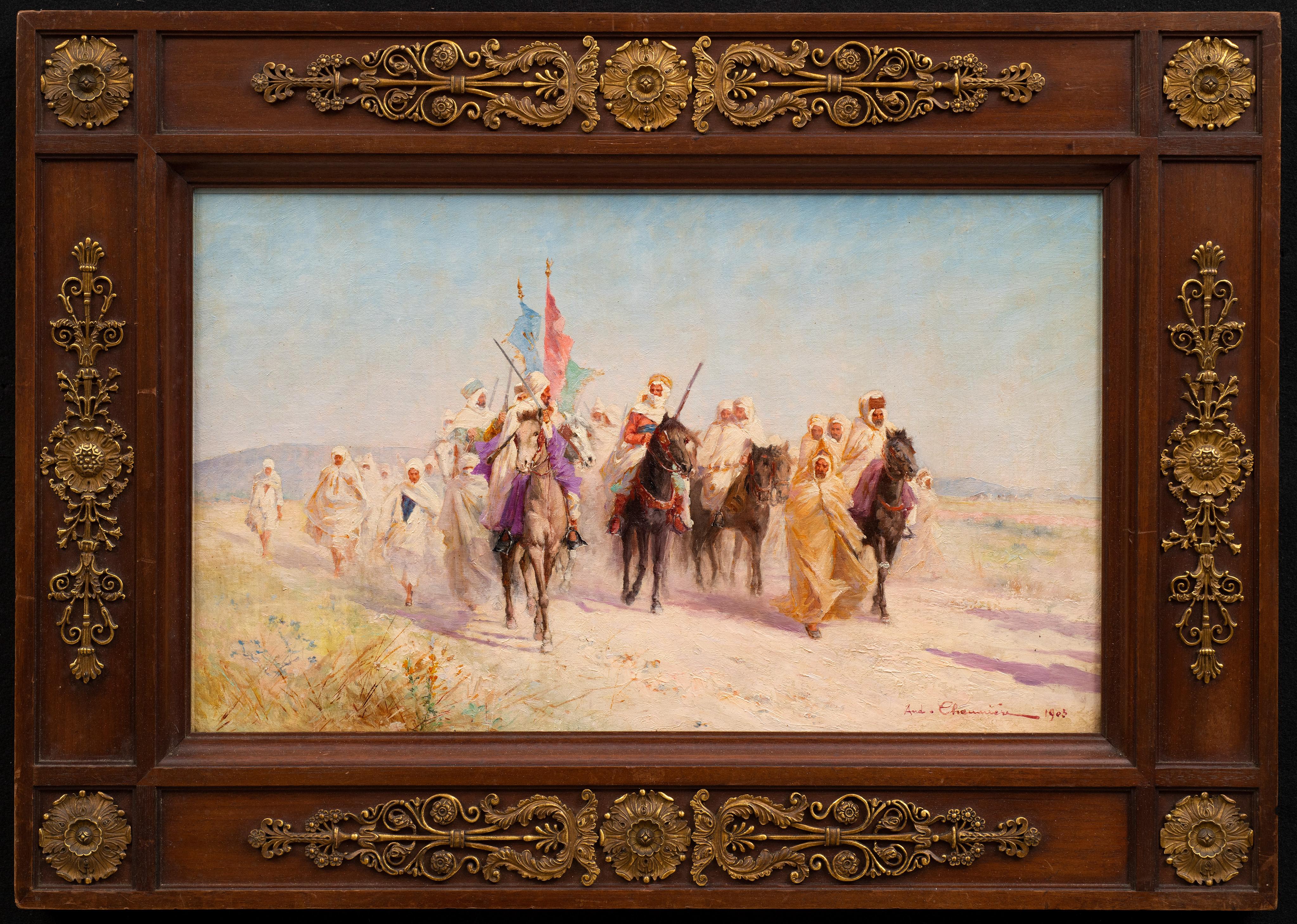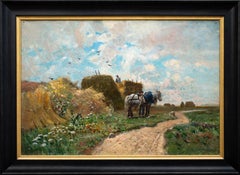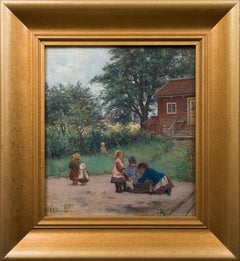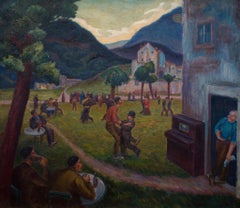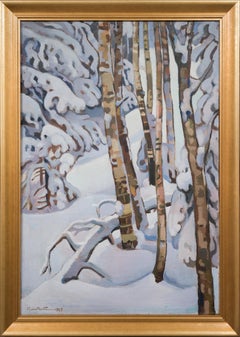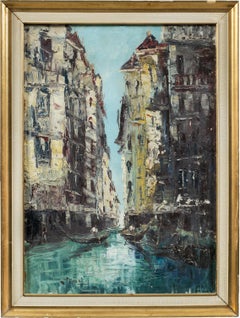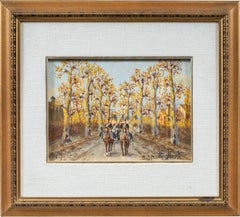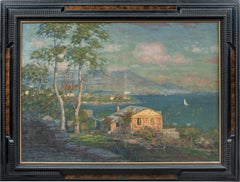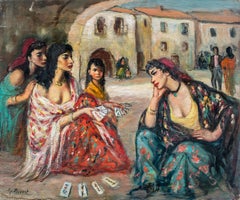Items Similar to Two Paintings in One, Art Nouveau Landscape And Winter Landscape. Oak Frame
Video Loading
Want more images or videos?
Request additional images or videos from the seller
1 of 9
Alfred EkstamTwo Paintings in One, Art Nouveau Landscape And Winter Landscape. Oak Framec. 1920s
c. 1920s
About the Item
Alfred Ekstam, a renowned artist from Mangskog, Sweden, is known for his exquisite landscape paintings. We are excited to present this painting by Ekstam, which is extra special because it is painted on both sides, offering two beautiful landscapes in one, with a reversible frame that can be turned over without having to take it down from the wall.
On one side, you will be mesmerized by a stunning Art Nouveau landscape with a purple tone, featuring a mountain in the background, a lake, and trees in the foreground with shades of yellow, red, and green. On the other side, you will see a winter landscape with five red houses, likely to be Ekstam's own farm in Knaggen. The winter scene showcases sun rays shining down on the houses, with a white and green tone.
Ekstam was known for his self-criticism, he took a long time to complete his paintings and he preferred to keep his beautiful creations for himself, resulting in the creation of only around 50 landscape paintings in total.
Ekstam's artistic talent was honed during his time in Rackstadkolonin, a colony of artists who gathered in the early 1900s in Värmland, Sweden. He was trained by the famous Swedish painter Gustaf Fjaestad. Ekstam's works are known for their ability to capture the beauty of nature with incredible detail and precision.
In summary, Alfred Ekstam's painting of an Art Nouveau Landscape on one side and a winter landscape with five red houses on the other is an extraordinary piece of art that captures the beauty of nature with intricate details. With its unique double-sided feature, it is sure to be a conversation starter and a prized possession for any art lover. Don't miss out on the chance to own this stunning piece by one of Sweden's most talented Värmland painters.
INFORMATION:
Alfred Ekstam (1878-1935) Mangskog, Sweden
Front: Art Nouveau Landscape
Back: Winter Landscape, Tobyn, Knaggen?
reversible oak frame by Christer Björkman.
frame dimensions 84 x 100 cm
Provenance:
Anna och Edward Karlsson, Mangskog
- Creator:Alfred Ekstam (1878 - 1935, Swedish)
- Creation Year:c. 1920s
- Dimensions:Height: 27.96 in (71 cm)Width: 33.86 in (86 cm)
- Medium:
- Movement & Style:
- Period:
- Condition:Excellent condition, bright and clear colours. A hand-made reversible oak frame that can be turned over without having to take it down from the wall.
- Gallery Location:Stockholm, SE
- Reference Number:1stDibs: LU1445211895962
About the Seller
5.0
Platinum Seller
Premium sellers with a 4.7+ rating and 24-hour response times
Established in 2020
1stDibs seller since 2020
179 sales on 1stDibs
Typical response time: <1 hour
Associations
International Confederation of Art and Antique Dealers' Associations
- ShippingRetrieving quote...Shipping from: Stockholm, Sweden
- Return Policy
Authenticity Guarantee
In the unlikely event there’s an issue with an item’s authenticity, contact us within 1 year for a full refund. DetailsMoney-Back Guarantee
If your item is not as described, is damaged in transit, or does not arrive, contact us within 7 days for a full refund. Details24-Hour Cancellation
You have a 24-hour grace period in which to reconsider your purchase, with no questions asked.Vetted Professional Sellers
Our world-class sellers must adhere to strict standards for service and quality, maintaining the integrity of our listings.Price-Match Guarantee
If you find that a seller listed the same item for a lower price elsewhere, we’ll match it.Trusted Global Delivery
Our best-in-class carrier network provides specialized shipping options worldwide, including custom delivery.More From This Seller
View AllHarvest Time by Hjalmar Sandberg, Swedish Artist, Oil on Canvas, Signed, 1876
Located in Stockholm, SE
Hjalmar Sandberg (1847-1888) Sweden
Harvest Time, 1876
oil on canvas
canvas size 14.96 x 18.11 inches (38 x 46 cm)
frame 18.70 x 25.59 inches (47.5 ...
Category
1870s Impressionist Landscape Paintings
Materials
Canvas, Oil
Mother Washing with Children Nearby
Located in Stockholm, SE
This delightful painting by Carl Ewald Lönngren captures a serene moment of rural life in late 19th-century Sweden. The scene shows a mother kneeling by a wash basin, surrounded by h...
Category
Late 19th Century Realist Figurative Paintings
Materials
Canvas, Oil, Board
Popular Dance at Corsica, I. By Swedish Artist Dick Beer, c.1924
Located in Stockholm, SE
Dick Beer (b. London 1893 - d. Stockholm 1938)
Folkliv på Korsika, I (Popular Dance at Corsica, I)
oil on canvas
signed Dick Beer
c. 1924
canvas dimensions 88 x 100 cm
Exhibited:
The Royal Academy Stockholm 1973;
Millesgården – Dick Beer – Impressionist & Kubist, 2012
Dick Beer was born in 1893 in London as Richard Beer, the youngest of five brothers. His father, John Beer (1853-1906), was a watercolourist who was born in Stockholm and left Sweden at the age of 17. John Beer instructed his sons in drawing and painting, among other things. A number of sketchbooks bear testimony to the boys’ talent.
Dick Beer’s parents died in 1906 and 1907. Barely 15 years old, Beer arrived in Sweden as an orphan. First he lived with relatives and finally he ended up at Reverend Laurell in Västergötland.
Dick Beer began his artistic studies at the Althin School of Painting in Stockholm in 1908 and continued at the Royal Academy of Arts in the autumn of 1910, but in September 1912 he broke off his studies and travelled to Paris. He rented a studio and enrolled at the Colarossi and Grande Chaumière academies.
In the summer of 1913, Dick Beer travelled to Pont-Aven in Bretagne in order to paint. In September the same year, he held his first solo exhibition in Stockholm which he gave the French title Exposition des tableaux de Bretagne et autour de Paris. The exhibition proved a success. Many of the paintings were executed in a light palette in a style inspired by the impressionists.
In 1914, Dick Beer undertook an extensive study trip to Italy, Tunis, Morocco and Spain, which resulted in canvases overflowing with colours and light. When the French army mobilised, he volunteered and was enlisted in the French Foreign Legion. In 1915 Dick Beer sustained severe head injuries in a grenade attack, which resulted in deafness and a nervous condition that would plague him for the rest of his life. Two of his brothers died the following year, fighting for the English army.
Dick Beer was hospitalised and convalesced at Château de Rochefort. Here he started painting again, in an impressionist style, a painting dominated by blue and green hues.
In 1918, Dick Beer married Ruth Öhrling, a dentist, and their son John was born later in the year. During this time, Beer began experimenting with cubist painting and created several large compositions, including the painting “The Arab Café”.
In the years that followed, Dick Beer was based in Paris, where he often moved house. He was instructed by André Lhote, who encouraged his students to work freely in the studio and provided them with individual critique. Beer often travelled to Bretagne or Provence. His artist friends came from all over Europe and included Amedeo Modigliani. Dick Beer exhibited fairly regularly in Paris between 1919 and 1934 and made a name for himself in French artist circles.
In the summers, Ruth regularly rented a house in the countryside, often at Lake Mälaren. She kept a large house with many models and friends and there was a lot of painting and discussions. In 1933, the couple divorced but Ruth still loved Dick...
Category
1920s Post-Impressionist Figurative Paintings
Materials
Canvas, Oil
Birch Trees and Snow-Laden Spruces, 1927
Located in Stockholm, SE
We are pleased to offer an exquisite painting by Finnish artist Reino Partanen (1889–1972), titled Birch Trees and Snow-Laden Spruces. Created in 1927, this impressive work measures ...
Category
1920s Post-Impressionist Landscape Paintings
Materials
Canvas, Oil
Ocean View from the West Coast by Swedish Artist Herman Österlund, 1916
Located in Stockholm, SE
Herman Österlund (1873-1964) Sweden
Ocean View from the West Coast, 1916
oil on canvas
signed and dated Herman Österlund 1916
canvas dimensions 14.37 x 16.73 inches (36.5 x 42.5 cm...
Category
1910s Naturalistic Landscape Paintings
Materials
Canvas, Oil
Peasants in a Cornfield (Boer in het veld) by David Teniers the Younger
By David Teniers the Younger
Located in Stockholm, SE
Remembering the magic of everyday life moments in the art of David Teniers:
The art of David Teniers the Younger (1610–1690) coincided with the heyday of the Flemish Baroque and captured a great variety of motifs of his time. In this painting of a seemingly simple peasant scene lies keys to understanding both the imaginative mind of Teniers as well as why this time period produced some of the most iconic works in all of art history.
As indicated by the name, Teniers was more or less born into his profession. As the son of David Teniers the elder, himself a painter who studied under Rubens, the younger David received training in art from a very young age and had no less than three brothers who also became painters. Because of his father’s frequent financial failures that even at times saw him imprisoned, David the younger helped to rescue the family from ruin through painting copies of old masters. Essentially, the young Teniers was confronted with painting as both a passion and creative expression as well as a necessity during difficult times, an experience that would shape much of his capacity and sensitivity in his coming life.
Despite the hardships, the talent and determination of Teniers was recognized and quickly expanded his possibilities. He had already spent time in France and possibly also England when he was hired by his father’s former teacher Rubens to help with a prestigious commission with mythological paintings, now considered lost, for Philip IV the king Spain. In 1644–54 Teniers was appointed dean of the Antwerp Guild of Saint Luke, manifesting his esteemed position within the artistic community. A few years afterwards he took an important step when relocating to Brussels, where Teniers yet again found new career opportunities that would prove to be very successful.
As the keeper of the collections of Archduke Leopold Wilhelm, a role similar to what we now refer to as an art advisor, Teniers purchased hundreds of important artworks that manifested the prominent status of the Archduke’s collection while at the same time providing an unusual access to inspiration and knowledge for Teniers himself. Since he kept on painting during the same time, his creative scope must have seemed almost bewildering in the great variety of images and stories that he surrounded himself with.
Regardless of how glamorous and culturally stimulating the career of Teniers was, he was as open to the charm and existential importance of everyday life as he was to works of great masters and luxurious collectibles. In his impressive repertoire of genres with everything from exquisite royal portraits, interiors, landscapes and history paintings he always added something new and inventive, highlighting the possibilities of art and importance of an experimental and intuitive mind. It is difficult to single out one aspect or genre to summarize his legacy, since it lies much more in the broad virtuosity across many motifs, although he is particularly remembered for farm scenes and meticulously depicted interiors where other paintings and artworks are captured with an astonishing precision. However, the fact that he is still today one of the most known and celebrated names of the Dutch Golden Age is a proof to the magic of his work, which continues to spark dialogue and wonder in the contemporary viewer of his works.
The farm boy in the field in this painting, which likely dates to the mature part of his career, is a wonderful entry into the mind of Teniers. In the tightly cropped motif, we see him standing right in the middle of the busy harvest when men, women and everyone capable were sent out in the field to collect the crop that formed the very core of their diet and survival. In the background we see a fresh blue sky interspersed with skillfully painted clouds, some trees reaching their autumnal colours and in the far distance the glimpse of a small church and village. The presence of a church in a landscape, so typical of Dutch art, served both a symbolic and visual function as a representation of faith while at the same time defining scale and distance.
In the field, the work is in full action with the farmers spread out in various positions, all in the midst of hard and sweaty labour. While they are portrayed as having nothing else than the work on their mind, our farm boy seems to have his attention directed elsewhere. Standing there with his white, half open shirt, flowy curls and strong, sturdy body; his gaze is directed away, out of the picture and the scythes in his hands. He looks almost smirking, expressed with tremendous subtlety in the slight smile of his lips and big eyes, being just in the middle of losing focus on the work. What is it that steals his attention? What has he seen, or realized, or felt – to break him free of the arduous task of harvesting, if but for a moment?
Here starts the wondering and the questions that are the hallmark of a great piece of art. Instead of explicitly locking in the motif in overly clear symbolism Teniers has chosen an open ended, subtle yet striking moment for us to consider. While it of course can be related to numerous other farm scene depictions of this time, and clever usages of gazes and real-life scenes to underscore various moral or symbolic meanings, the painting can be much more of a contemplation than an explanation or illustration. The ordinary nature and understated yet emotionally textured composition of the motif gives greater space for our own reactions and thoughts. Has he seen a pretty farm girl just passing by? Is he fed up with the farm life, joyously dreaming away for a minute, imagining another future? Or is he simply in need of distraction, looking away and ready for anything that can steal his attention?
One quality that never seem to have escaped Teniers was that of curiosity. During all of his career he constantly investigated, expanded and experimented with not only the style and technique of painting, but with the vision of art itself. Being credited with more or less introducing farm motifs for a broader audience not only tells us of his ability to understand the demand for different motifs, but the sensitivity to transform seemingly ordinary parts of life into deep aesthetic experiences, far beyond their expected reach. The farm boy in this painting is, of course, exactly that. But with the help of one smirk the entire picture is charged with a different energy, awakening many contrasts and relationships between the calm landscape, the hard work and his own breach of effectivity, holding sharp scythes while thinking or seeing something else.
It is no wonder Teniers chose to work with farm scenes as a way of investigating these intricate and delicate plays on expectations and surprises, clarity and ambivalence. It invites us to an appreciation of human everyday life that connects us with the people of 17th century...
Category
Late 17th Century Old Masters Landscape Paintings
Materials
Canvas, Oil
You May Also Like
Vedutist Venetian painter - early 20th landscape painting - View of Venice
Located in Varmo, IT
Venetian painter (early 20th century) - View of Venice with canal and gondolas.
70 x 50 cm without frame, 81 x 61 cm with frame.
Oil on canvas, in a gilded wooden frame (small sign...
Category
Early 20th Century Art Nouveau Landscape Paintings
Materials
Canvas, Oil
Vizzotto Alberti (Venetian realist painter) - early 20th century figure painting
Located in Varmo, IT
Enrico Vizzotto Alberti (Oderzo 1880 - Padua 1976) - The 7th regiment of Milan lancers.
25.5 x 35 cm without frame, 51.5 x 57 cm with frame.
Ancient...
Category
Early 20th Century Art Nouveau Landscape Paintings
Materials
Canvas, Oil
$803 Sale Price
53% Off
Free Shipping
Carlo Tagliabue (Milanese painter) - Early 20th century landscape painting
Located in Varmo, IT
Carlo Costantino Tagliabue (Bresso 1880 - Milan 1960) - The Gulf of Rapallo.
100 x 140 cm without frame, 129 x 169 cm with frame.
Oil on canvas in carved wooden frame.
- Work sign...
Category
Early 20th Century Art Nouveau Landscape Paintings
Materials
Canvas, Oil
Georgette Nivert (French painter)- 19th century figure painting - Spanish girls
Located in Varmo, IT
Georgette Nivert (French, c. 1900) - The Spanish Women.
54 x 65 cm.
Old oil painting on canvas, without frame.
- Work signed lower left: "G. Nivert...
Category
Late 19th Century Art Nouveau Figurative Paintings
Materials
Canvas, Oil
$1,147 Sale Price
50% Off
Free Shipping
Vedutist Venetian painter - early 20th landscape painting - St. Mark Venice
Located in Varmo, IT
Venetian painter (early 20th century) - Carnival in Venice in Piazza S. Marco.
40.5 x 55 cm without frame, 46.5 x 62 cm with frame.
Oil on canvas, in a carved and gilded wooden fra...
Category
Early 20th Century Art Nouveau Landscape Paintings
Materials
Canvas, Oil
Orientalist: "Arabian Horseman" dated 1903 André Chaumière
Located in SANTA FE, NM
"Fantasia of Arabian Horseman" dated 1903
André Chaumière (French, XlX-XX)
Oil on canvas
Handcrafted original wood frame with bronze applique
20 3/4 x 12 3/4 (28 1/2 x 20 frame) inc...
Category
Early 1900s Art Nouveau Figurative Paintings
Materials
Canvas, Oil
Recently Viewed
View AllMore Ways To Browse
Art Precisionism
Yellow Art Nouveau
Swedish Art Nouveau
Art Nouveau Purple
Art Nouveau Canvas
Oak Art Nouveau
1920s Painting Green
Oil Painting Around 1920s
Swedish Mountains
Oak Tree Oil Painting
1920s Farm Painting
Alfred Ekstam
The Montauk
Alpine Landscape Painting
Jean Hill
Oregon Coast
Texas Ranch Art
Antique Sheeps Paintings Landscaping
